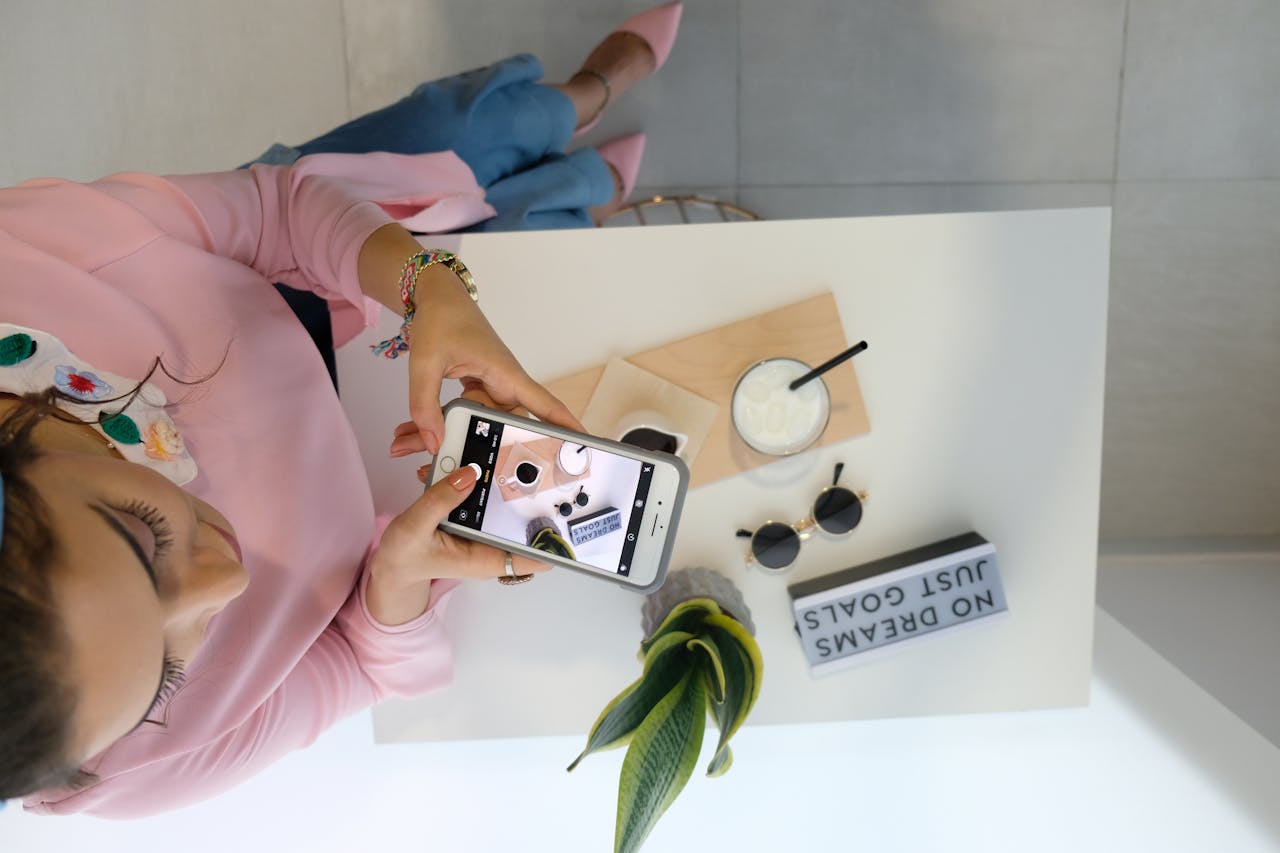With consumerism and over-consumption becoming quite popular topics on social media these days, creating authentic advertisements for a good or service is more important than ever. Long gone are the traditional ads, and in are the days of user-generated content (UGC).
Rather than creating content in a studio that audiences have a harder time relating to, UGC offers a way for brands to leverage the creativity and voices of their customers and followers to help build trust and boost sales. If this is something you’re considering for your business, you’re in luck. We’re breaking down everything you need to know–from the benefits to how to make UGC content work for you.
What is UGC?
User-generated content (UGC) is any content—such as photos, videos, testimonials, reviews, or social media posts—created by consumers or content creators rather than brands themselves. This content helps brands appeal to their audience organically, as it reflects real customer experiences.
This unfiltered look at how products and services fit into someone’s everyday life helps build trust, create a community, and showcase a brand’s value without resorting to obvious ads.
The Difference Between UGC and CGC
While UGC and CGC (creator-generated content) may seem similar, there’s a key distinction between the two. UGC refers to any content created by users or fans of a brand, including social media posts, reviews, photos, or videos. These users might not necessarily be customers but could be individuals engaging with the brand for other reasons, such as sharing opinions or ideas.
CGC, on the other hand, is content that is made by creators for a brand to use on in their own marketing efforts. This content often performs better because it is professional-quality but has the look and feel of an influencer post.
 Why UGC Matters for Your Brand
Why UGC Matters for Your Brand
According to a study done by Search Logistics, 79% of consumers say that UGC highly impacts their purchasing decisions. They also found that it can result in up to 29% higher conversion rates than campaigns that don’t use it. Those aren’t stats that you can ignore. However, if you’re still unsure whether it’s right for your business, look at some of the benefits.
Benefits of UGC
- Social Proof – Social proof is a psychological phenomenon where people place a big importance on the actions and feedback of others when making decisions. When consumers see others using a product, they are more likely to trust the brand and consider purchasing. For example, if someone is shopping for skincare products and sees beautiful before and after photos, they’re going to have faith that the product works more than they would seeing a traditional ad without these real-life examples.
- Word of Mouth – UGC is the modern equivalent of word-of-mouth marketing. When consumers share their positive experiences across social media platforms, they help increase organic reach.
- Cost-Effectiveness – One of the biggest benefits of UGC is its cost-effectiveness. Instead of spending a lot on production, brands can rely on the content customers already create. You’re essentially outsourcing some content creation to loyal fans.
- Engagement – UGC tends to have higher engagement rates than brand-created content because it’s less polished. UGC creators are natural storytellers, and this relatability makes the content feel like it comes from a real person rather than a corporation, which can be huge for consumers.
Types of User-Generated Content
Photos and Videos
These are the most common types of UGC, particularly on visually-driven platforms like Instagram, Pinterest, and TikTok. People naturally love sharing snapshots of their lives, including products they’re currently obsessed with, and as a brand, you can capitalize on this. It’s also the easiest to gather since these apps are some of the biggest when it comes to social media usage.
Reviews and Testimonials
Online reviews are crucial for e-commerce success. Customers often rely on reviews from other shoppers to decide whether or not to purchase a product. Real customer testimonials or reviews on your product pages may seem like a small addition, but they can provide additional credibility that will make or break a sale. For example, Amazon thrives on user-generated reviews, which influence millions of purchasing decisions every day. According to Matt Moog of Power Reviews (via LinkedIn), one review of a product makes it 65% more likely to be purchased than a product with no reviews.
Branded Hashtags
To make finding UGC easier for yourself, encourage customers to use branded hashtags in their posts. This not only cuts down the time it will take you to collect and track UGC, but it also helps your customers feel more connected to your brand, as their content may be reposted or featured on official channels.
Blog Posts and Forum Discussions
Although blogging looks vastly different than it did a decade ago, there are still countless consumers out there who share their in-depth thoughts and experiences through blogs or forum posts. These long-form reviews or discussions typically offer detailed insights that can help establish a brand’s credibility. This works particularly well in the beauty, skincare, and tech spaces.
 How to Create a UGC Campaign
How to Create a UGC Campaign
A successful UGC campaign doesn’t happen by chance—it requires a strategic approach. Here’s a step-by-step guide to launching your own UGC campaign.
Identify Your Goals
First things first, you need to clearly define what you want to achieve with your UGC campaign. Are you looking to increase brand awareness, grow your social media following, or drive more sales? Your goals will shape the type of UGC you seek and how you implement it.
If your goal is brand awareness, you may focus on incentivizing users to post content with your branded hashtag. The more people see the hashtag, the more familiar they become with who you are and what you do.
Choose the Right Platforms
The type of UGC you use depends entirely on what social media platforms you want to focus on. As we mentioned earlier, Instagram and TikTok are ideal for photo and video content, while X and Threads work well for shorter, conversational posts. Consider where your audience is most active and focus your efforts there.
Incentivize Participation
If you’re hoping to gain some UGC content naturally (versus paying for an influencer campaign), encourage your audience to share content by offering incentives, such as giveaways, contests, or exclusive access to new products. The easier and more rewarding it is for users to participate, the more content you’ll collect. A travel company, for instance, might launch a photo contest, offering a free vacation to the user who shares the best photo from their trip.
Find Loyal Customers
There’s no better way to find UGC content than to find your loyal customers. Search your tagged photos or videos, or take the time to go through your brand-specific hashtag to find content that interests you. By focusing on these existing relationships, you can develop a network of brand advocates who have already loved your brand previously and can help spread the word in the most natural way possible.
Why UGC Creators are Important
UGC creators are everyday users or influencers who create and share content related to your brand. These creators range from casual fans who post about their experiences to more established influencers who partner with brands to promote products authentically. For many brands, paid campaigns with influencers are one of their most vital marketing tools. These influencers help with:
- Expanded Reach – Influencers have their own well-founded following, which allows your brand to reach new audiences through their content.
- Authenticity – Content from creators is more authentic and relatable than traditional ads, making it easier for their followers to trust your brand.
- Steady Content Stream – We understand that creating new content 24/7 is a big ask. By collaborating with creators, you can continuously generate fresh content for your social media platforms, website, and other marketing materials.
- Long-Term Relationships – Developing relationships with UGC creators can lead to long-term partnerships, which is beneficial for both the brand and the influencer.
How to Leverage UGC for Marketing Campaigns
If you’re ready to include some UGC content into your marketing strategy, there are a few ways to do so–and yes, they go beyond just your social media posts.
Social Media Posts
Repost UGC on your brand’s official social media accounts. Not only does this show appreciation for your customers, but it also encourages more users to create content. This can be especially true if your brand has a product that varies for everyone. For example, an activewear company can benefit from sharing their clothing on different body types so that their audience can get a better mental picture of how it would fit them.
Product Pages
While official product photos taken in a studio are beneficial, featuring UGC on product pages can significantly boost conversion rates. When shoppers see real customers using and enjoying the product, they’re more likely to trust the purchase.
Marketing Emails
Email marketing is tricky. You want to entice your audience without seeming too spammy. One wrong email can lead to clicking the “unsubscribe” button and losing the sale. That’s where UGC comes in. When done correctly, it can make your messaging feel more personal and authentic, which is extremely important in email campaigns. Featuring real customer stories or photos can improve engagement and increase click-through rates.
Paid Ads
Last but not least, UGC can even be used in paid ads. Unlike traditional ads, UGC-powered ads have a more authentic feel, making them more relatable and trustworthy–and when you’re spending money on things like paid ads, you want to make sure you’re getting the most bang for your buck.
Measuring the Success of a UGC Campaign
To determine the success of your UGC campaign, track the following key performance indicators (KPIs):
- Engagement Rates – How many likes, shares, and comments are UGC posts generating?
- Brand Reach – How much has the campaign expanded your audience?
- Conversions – Are these campaigns translating into more sales or follows?
- Content Shares – How often is the UGC shared across different social media platforms?
UGC marketing allows you to build trust, generate buzz, and authentically engage your audience. While you can gather UGC naturally, if you’re looking for influencers to help ensure that you make the most out of the UGC content you share, Sway Group can find you the perfect match. With a network of over 50,000 influencers, we’ll help you partner with someone whose content will be authentic for your brand so you can feel confident in your campaigns. Ready to get started? Contact us today!
